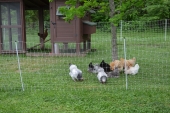Briana Great wrote:
for the past two years, our girls have been pooping EVERYWHERE and eating everything.
Interesting you
should say that - the daily-ish just had a
video from Paul (
https://www.youtube.com/watch?v=mskHqJelfiU ) that is essentially complaining of exactly that issue. Chickens can be wonderful for pest control and providing eggs, but raising them frequently requires compromises!
Your numbered problem list:
1. Any newly planted area will be destroyed by chickens, so I agree your plan should either contain the chickens elsewhere, or exclude them from the
hugel.
2. My kid *always* complained if his play area was covered in chicken shit, so again, we need a system where the two needs can work beside each other.
The visibility bit - do they mean visible from the street? Or from anyone else's backyard? This definitely suggests we want some chicken-friendly shrubs like mulberry as a visible shield, a coop that either looks like it isn't a coop, or is camouflaged in colour or style.
3. I've got no
experience with
rabbits other than the wild ones that thankfully the Great Horned
Owl keeps sufficiently under control that my garden isn't too damaged by them.
If you've read Paul's big comparison of chicken management options, he's clearly in favor of what is referred to as a "paddock-shift" system. The idea is that you designate 4 to 6 areas that can contain the chickens and either the coop is stationary (in which case you'll need a way to deep mulch it - think composting toilet - done *right* it won't be stinky, done wrong it's totally yucky) or the coop can move to connect to or be enclosed by the fencing around each area, or a combo of the two.
A)
Stationary coop with a protected "all season safe deep mulched run" with 4-5 pop doors that lead to fun chicken areas that the birds get to visit on a rotating basis. You could definitely plant a fruit tree in each of those areas, but if you're talking mini-trees, they'd need total protection. The idea is though that the chickens would be fertilizing around the tree beyond the protection. You can also plant shrubs and trees that the chickens benefit from or that people benefit from if you can keep the chickens from destroying them by both making sure they aren't in the area too long at a stretch and making sure there's lots of mulch in a gully so they're inclined to dig there and not places you'd rather they didn't dig. Chickens are strongly insectivorous - a mulch pile with goodies that attract worms and bugs will keep them entertained and happy. The downside is that you are basically chopping up your backyard with fencing.
B)
Movable coop with electric fencing. Often this approach is used with quite a small coop that really only has
enough space for night-time and egg laying. Frequently, these systems aren't designed light enough to be really easy to move, so they end up being left in one spot with a moonscape around them. Electric mesh fencing is heavier and tangles more easily than you might think, which makes it more time-consuming to actually use unless you've got several experienced people to help.
C)
Some sort of hybrid. A mixture of portable and permanent fencing. Things like "chunnels" - chicken tunnels that direct the chickens to the location you are willing to let them play for a week.
What you don't want is to give the chickens free access to the whole yard, all the time as the areas don't get recovery time. Think in terms of packs of animals that travel to both find fresh food and avoid predators. I know for experience that chickens like fresh grass - and pay no attention to poopy grass unless they're desperate.
As for exactly what the coop should look like, I'd spend some time on google images just looking at all the alternatives. Personally, I agree with those who recommend 8 square ft/bird for small flocks when possible because in a small flock in a small coop there's just no where for a bird to hide or have quiet time. With 50 birds, they can "hide" in the masses, but not if only 10 birds. I also agree with keeping it as light as possible, having all infrastructure (nest boxes, perches, feeders etc) easily removable for cleaning, having good ventilation, using hardware cloth rather than chicken wire for predator protection, and having *really* good wheels on it so that moving isn't too hard. Think about how you've got a sick bird in a back corner and you're going to have to fetch it - can you open areas to access?
I think this is a great family
project and your kids will hopefully learn a lot - good luck!


















 1
1






